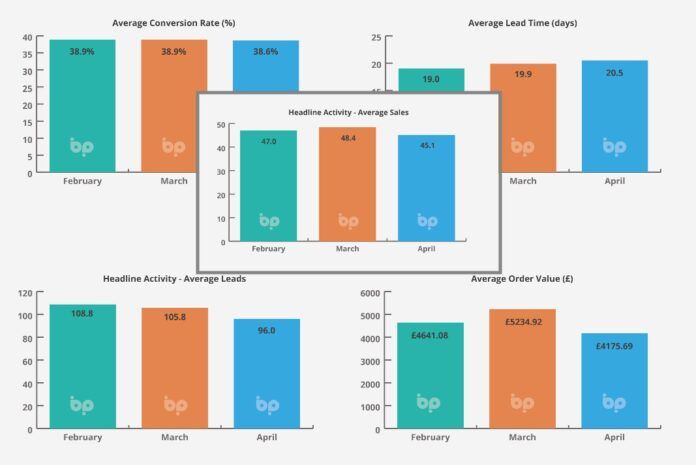
Neil Cooper-Smith, senior analyst, Business Pilot
The Business Pilot Barometer offers monthly analysis of the key trends defining window and door retail. It draws on real industry data collated by Business Pilot, the cloud-based business management tool developed by installers, for installers.
This time last year, I reported: “We are seeing a slowdown. Average window and door sales in April dropped 13% on March, while leads dropped by 20%.”
Now, there is a sense that last month’s lower sales are an indication that the cost of living crisis is finally biting. Average window and sales this April were down 7%, while leads were down 9%.
Things slowed last month but what is clear from the 2022 figures is that it doesn’t signal the arrival of a downturn. Most window and door companies would have been happy with their bottom lines come the close of the financial year. There is no reason – so far – to indicate that they won’t be again. A lot of the economic conditions remain the same, if not slightly improved.
Despite the fall in sales seen from March to April, year-on-year sales are up 17% in April 2023 compared to 2022. Leads are also up year-on-year by a more modest 3%, despite a month-on-month fall from March to April 2023 of 9%. The 9% drop in leads from March to April is the figure to track going forward.
Conversion rates have remained at around the 38% mark for the last three months. This suggests a drop in sales this month by about the same, which would in theory lead to smaller fabricator order books from late May into June.
Average order values were down 20% from March to April this year, and 24% year-on-year. Monthly fluctuations of this kind are not uncommon month-on-month, and so again should not be interpreted in isolation as a signal of a slowdown.
Stubbornly high inflation (still at 10.1%) and the cost of living crisis, is probably having an impact. That said, the closely watched GfK Consumer Confidence Index at the end of last month found that consumer confidence had increased, rising by six points to -30. Consumers also felt more confident about their personal finances, signalled by an eight-point increase to -13, and they were prepared to spend on big-ticket items, as the big purchase index was at its highest level in a year at -28.
While it isn’t guaranteed that renewed consumer confidence will convert into home improvement spend, it is a prerequisite, which is why projected figures for May, based on current leads in April, have the potential to exceed expectations. It is also worth reflecting on the fact that people over 65 are sitting comfortably on a record £2.2tn in mortgage-free housing wealth. Close behind them, according to last month’s research by Savills, are owner-occupiers aged 50-to-64, who reportedly hold £1.53tn. These groups may not be immune from inflation but they are not feeling the same dent in their finances. Still high energy bills and the end of government subsidies next month, give them a very real reason to invest.
There is more of an affordability gap for other socio-economic groups but the incentive to improve the energy efficiency of their home remains, which is why we believe finance is increasingly important in driving conversions, for those who aren’t lucky enough to have seen their housing wealth double in a decade. With sophisticated lead tracking capability, lead heat mapping and a sales pipeline management tool, Business Pilot helps maximise leads and support their conversion through strategic data management and analysis. It also helps maximise profitability on every job, through drag-and-drop installation scheduling and real-time financials.



